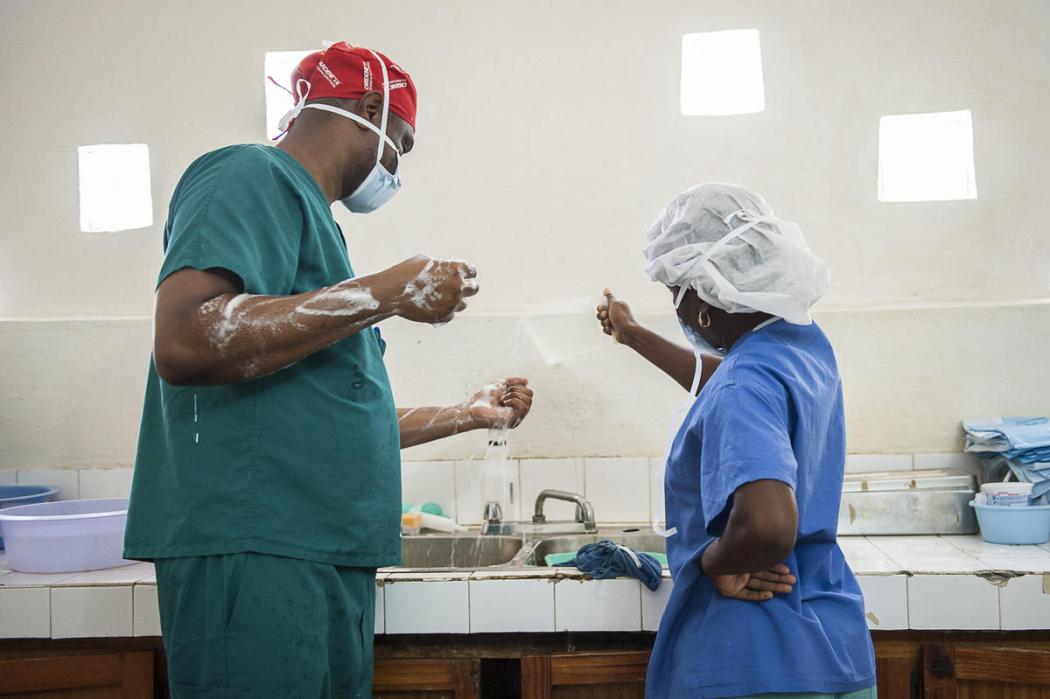Top Reads and Resources for Hand Hygiene in Health Facilities

A nurse pours water from a pitcher to help the surgeon scrub for a cesarean section at St. Therese Hospital in Central Plateau, Haiti. © 2014 C. Hanna-Truscott/Midwives for Haiti, Courtesy of Photoshare
May 5th is World Hand Hygiene Day, a global advocacy day celebrating clean hands in health care. This year’s theme of “Clean care for all – it’s in your hands” emphasizes the links between good hand hygiene and universal health coverage (UHC). The ambition of UHC is not only about access to care, but about quality, and clean hands are a non-negotiable aspect of quality health services. Hand hygiene is one of the most effective ways to prevent health care-associated infections, which affect about 1.5 million people at any given time.
This Hand Hygiene Day, I am rounding up five key resources to help understand the role of hand hygiene in UHC:
Learn about what hand hygiene means: In health care, hand hygiene refers to cleaning hands with soap and water, or handrub, at five key moments: before touching a patient; before any clean/aseptic procedure; after body fluid exposure or risk of exposure; after touching a patient, and after touching patient surroundings. These moments are in addition to the critical times that apply to everyone, such as after using the bathroom or before handling food. The World Health Organization’s 5 Moments for Hand Hygiene web page and guidelines explain what more about proper hand hygiene is, why it matters, and how to implement a hand hygiene program.
My take-away: Health workers need to clean their hands a lot to keep themselves and their patients safe. Infection prevention and control is a significant part of anyone’s job in a health facility.
Understand the current state of hygiene in health facilities: The World Health Organization and UNICEF’s Joint Monitoring Program (JMP) global baseline report on WASH in Health Care Facilities measures access to water, sanitation, and hygiene (WASH) in health facilities worldwide. In health facilities, basic hygiene is defined as: Functional hand hygiene facilities (with water and soap and/or alcohol-based hand rub) are available at points of care, and within five meters of toilets. The JMP found that 1 in 6 health facilities in the world had no hand hygiene facilities at all, while 43% lacked facilities at points of care.
My take-away: The hygiene infrastructure challenge is huge, and solvable. If a facility lacks soap, water, and place to wash hands, quality health services simply won’t happen.
Hear how this affects health workers: This past Global Handwashing Day, we collected stories about how handwashing effects health workers every day. This post, The Chicken or The Egg: Hand Hygiene Infrastructure vs. Behaviors in Healthcare Facilities shares what WASH in health facilities looks like up close in Ethiopia, and what the data doesn’t tell us about handwashing in health facilities. For example, when sinks are available, staff may be deterred by waiting times or simply not have the habit of cleaning their hands between patients. Another post, Every Newborn Deserves Caring, Clean Hands, shares data on barriers to hand hygiene, and calls us to action to stop the 300,000 newborn deaths caused by infection every year.
My take-away: Without access to hygiene facilities, health workers have an impossible choice between not caring for a patient or giving care they know might make them sicker. Hand hygiene policies and facilities are a major part of supporting health workers.
See how health workers are changing things for the better: This year the Global Handwashing Partnership has profiled a series of leaders in hand hygiene, and documented how they are improving hygiene in their health facilities. We started with the story of a nurse in Cameroon, who combatted newborn sepsis by developing a program for local production of handrub. This was followed by a hospital executive in the United States who used a new technology to increase accountability for hand hygiene, and then saw a dramatic drop in c. diff infection. In both cases, these leaders credited staff accountability, leadership buy-in, and evidence as key factors allowing them to make these changes.
My take-away: Yes, infrastructure and investment are needed. But hand hygiene leaders aren’t waiting. Examples from diverse settings show how good leadership, clear accountability, and a focus on quality are helping facilities improve.
Find out how to get involved: Now that you’re an expert on hand hygiene, start advocating! Join us in a Twitter storm on May 5 at 10 am EDT by tweeting your example of how hand hygiene contributes to universal health coverage using #HHforUHC.
The World Health Organization’s campaign page includes a social media toolkit and activity ideas; and the Global Handwashing Partnership’s hand hygiene advocacy pack provides tools and templates to help anyone be a hand hygiene advocate.
My take-away: Hand hygiene is related to so many issues in health, and there are tools you can use today to spread the word. Join us in calling for better hand hygiene for all!
